|
DELPHI
by
H. Braley
The Sanctuary of Apollo at
Delphi: A compellingly beautiful and mysterious place full
of history and myth is named after the sun god. This is curious,
and even on our visit to this place, little or no mention was
made of the goddess that most likely first marked this sacred
place. The story tells us that Apollo killed a giant serpent,
a snake called Pythos. But having broken his own law against murder
he banned himself from Delphi, the place of the slaying, for a
period of eight years.
|

|
|
|
As in Athena's situation where she calls
herself Pallas Athena, Apollo takes on the name Apollo Pythius. Nevertheless,
there is evidence of earlier pre-Greek inhabitants who worshipped a
goddess, and that the name of Delphi was actually Pytho. The myth then,
of Apollo and the slaying of the Python, most likely represents the
overthrow of that society.
In the opening lines of Aischylos' tragedy
Eumenides, the Pythia, prophetess/priestess of the oracle, tells us
that Gaia the mother of the gods was the first diviner to occupy the
Delphic oracle and that she was succeeded by two more daughters. So,
as with most of the ancient myths and legends, a variety of the tales
and histories exist surrounding any one site or event. What is rarely
debated, is the fact that Delphi was a sanctuary of great importance
for a relatively long period of time, and to a wide variety of people.
Another myth of Delphi involves Zeus
and his search for the center of the earth. To find the center or navel,
Zeus let loose two eagles each from the opposite ends of the earth.
Where the sacred birds met would be the center-They met at Delphi. The
striking omphalos, a carved stone marker identifying that place can
be seen in the museum at Delphi. I had seen this omphalos in books,
but I was not prepared for its actual size. Originally I expected it
to be like other land markers about knee high. Instead it was massive,
a few feet tall, and with a great circumference. The sanctuary itself
housed this omphalos, and pilgrims brought numerous smaller versions
as offerings to this place.
|
|
Even the geography of the place
is majestic. The sanctuary is built part way up the slopes of
a steep mountain face. Behind the sanctuary the mountain is very
steep, rocky, and navigable only by mountain goats. Below, is
a fertile valley, home of the largest olive grove in Greece. Beyond
the grove is a harbor village, and a glorious view of the gulf
of Itea.
|
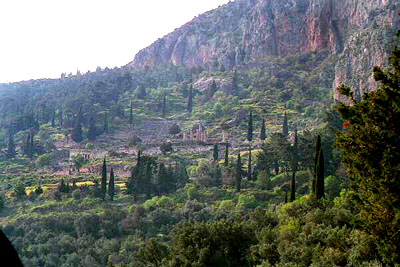
|
|
| We are told that on first
entering the Sacred Way (the path leading to the main sanctuary), that
the most extraordinary beauty, architecture, and collection of statues
and votive offerings surrounded the pilgrim. The ambiance must have been
powerful. Politically, this was a sort of Geneva. Friends and enemies
could coexist under the protection of Apollo, and the opulence of the
place was due in large part to the grand gifts of the various Greek cities.
Accurately written details of the thousands of statues, their dedicators,
and detailed descriptions along with the dates and reasons for the gifts
provide a clear picture. Great pride was taken in these offerings, and
the cities competed with their presentations. |
|
Continuing along the Sacred Way,
treasuries were built to house the even more precious offerings
that were brought out on special occasions and used in sacred
processions. One such occasion would be the Pythian games which
were second in popularity only to the Olympic games. Most of these
treasuries were built about one third of the way up the path,
at the first turn in the road. All the treasuries were built with
an architecture providing at least two columns on the proaia.
The most famous of these, the Treasury of the Athenians, held
a prominent location next to the Council House. On the other side
of the Council House is the rock of Sybil, and just beyond that
towered the Sphinx of the Naxians.
Passing the treasuries one has
approached another turn in the path. But just before the turn,
to the right, is a rock paved area called the Halos (threshing
floor). This area was used to re-enact the Septeria, a holy drama
depicting the killing of the serpent by Apollo.
|
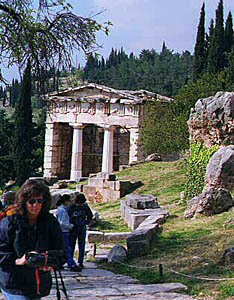
|
|
|
Also at this turn, the structure
of the polygonal stone retaining wall that supports the large
temple, and the prominent area of the sanctuary can be admired.
This architectural accomplishment is difficult to appreciate in
our time, and even more difficult to have accomplished then. After
this turn, one approached the altar to Apollo and then the temple
itself.
The excavated temple is the third
to have been built there. It was built in the 4th century BC,
and this is where the Pythia is said to have uttered her last
oracle. Most of this information comes from ancient writers. For
the most part, the excavations have not shed additional light
on the structure and formations of the temple. It's destruction
was total, and most likely intentional.
|
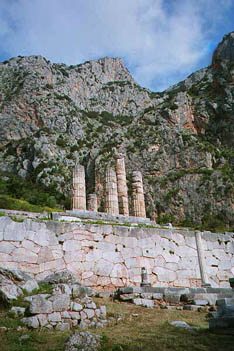 |
|
|
Beyond the temple there are small
narrower paths not considered part of the Sacred Way. These paths
lead to the theatre, and further beyond that to the stadium. On
the day of our visit, we made our way to the final destination,
the stadium. We jogged the distance and imagined what it must
have been like filled with athletes and spectators. In partial
restoration were small structures that looked like thrones at
one end of the stadium. There was speculation as to whether they
were for judges, or athletes. At this elevation, our imagination
posed the question of what else lies beneath the mountainside.
|
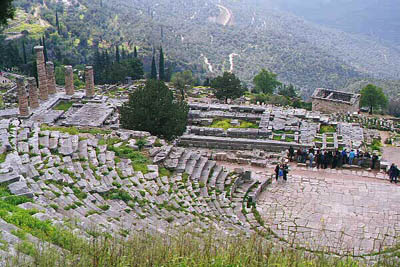 |
|
| Over all, and
even for what I have described here, the entire sanctuary is not a terribly
large place. Considering the thousands and thousands of visitors that
came to the oracle, there must be other structures in the area. Indeed,
two more known features should be mentioned. |
|
Below and just to the east of the
Sanctuary of Apollo is the Sanctuary of Athena Pronaia as some
still call it. It is also known as Marmaria. It is another beautiful
site, in a beautiful setting that contains one of the few round
buildings in ancient Greece. The purpose of the round structure,
called a Tholos, is still a mystery. And like the ones at Epidaurus
and Olympia, they represent some of the most stunning examples
of Greek architecture. At least a couple of treasury type structures,
an Archaic temple, and a later temple built to Athena are present
at this site. The name Athena Pronaia, comes from the fact that
the pilgrim, headed to the Sanctuary of Apollo, would come upon
this place first-"pronaia" meaning "before."
|
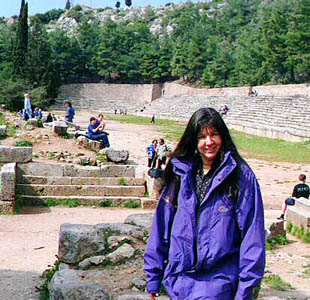 |
|
|
Archeologists suspect that this
must have been a place where a goddess was worshipped long before
what we know about this present sanctuary. They attribute this
to the numerous Mycenaean figurines representing a goddess with
outstretched arms found at the site.
One more feature, and a rather
unforgettable one, is the Kastalian Spring between the two sanctuaries.
Crucial in the founding of these sanctuaries, the spring water
was also involved in the rituals.
|
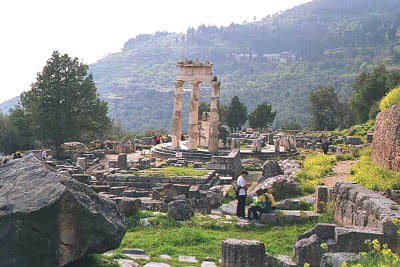
|
|
| However, what can be seen
today is, for the most part, from the Roman times. The spring has been
routed through a pipe and is thoroughly drinkable. The pool nearby is
dry now, but it doesn't take much imagination to see how inviting it would
have been to tired pilgrims, and those seeking purification. When we were
told it was safe to drink the water, I quickly dumped my purchased bottles
and refilled them at the spring. I was still sipping that spring water
by the time we reached the monasteries in Meteora.
|






